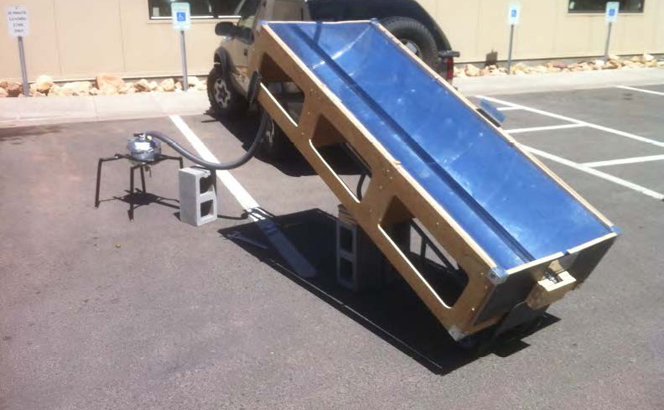A mind bent on improvising can twist the mundane into utility, and that is no small matter in a developing country. But when the minds are from a country rich in resources, the biggest challenge can be to imagine scarcity.
The solar autoclave, a potentially life-saving device for sterilizing medical equipment, embodies the improvising spirit while employing the ingenuity of senior engineering students inspired by their Northern Arizona University professor.
“This project is something that I had been thinking about,” said Brent Nelson, assistant professor of mechanical engineering and a co-adviser for Engineers Without Borders. Nelson, who teaches heat transfer, understood the potential of a simple sterilization device, but his research into the topic found many published solutions to be lacking.
Design and technology for the developing world, Nelson explained, takes a mindset that often eludes Western thinkers.
“One of the big problems is that most people design Western products that then are deployed in a remote place, and that just doesn’t work,” Nelson said. “The design relies on things you can get in a supermarket but not in sub-Saharan Africa.”
With the idea that medical sterilization is “just heat, and heat’s not that hard to do if you’ve got sun,” Nelson floated his idea to mechanical engineering students looking for a senior capstone project, and he found some eager takers.
Eric Brettner, team leader of the five-student group that produced the innovative design, said he and his fellow team members were drawn to the idea “not because we knew a great deal about the project, but because we knew nothing about it. That gave us the advantage of thinking outside the box and really challenging ourselves.”
Immediately, they faced Nelson’s fundamental expectation to “design something that was maintainable and replaceable, both with things that were cheap and available in remote places, and things that could be improvised.”
Bettner said part of the team’s motivation was a full appreciation of the potential to make a tangible difference.
“We saw the statistics about illness and disease in developing regions, so we funneled that into knowing we could make a difference,” Bettner said. “One life changed is all we were aiming for.”
Team member Adam Compton spent the first semester of the project modeling the heat transfer analysis by creating a resistor network that simulated the solar autoclave. Then he and teammate Kyle Godwin manufactured the all-important trough, lined with sheet metal, which would collect the sunlight. Through woodwork and metal work, they created the parabolic ribs that gave the trough its shape. Once construction was complete, “all we needed was some sun and the device would do the rest,” Compton said.
Other team members on the project included Blake Lawrence and Yuchen Liu. All five graduated with degrees in mechanical engineering in spring 2013.
In the end, Nelson said he was “pretty happy overall” with the outcome, which has been published in the Engineering for Change newsletter and has been submitted to an international journal.
“Where it goes from there is an open question,” Nelson said. “It would be nice to be able to deploy it, but it’s a matter of finding the right partners.”
While the solar autoclave rests in Nelson’s lab, awaiting an opportunity, all of the students are moving forward with the benefits of completing a senior capstone project.
“One of my favorite things about capstone is that you have to think back to your other classes and pull that information in,” Nelson said. “Students work on a problem, utilize the knowledge they already have, and figure it out outside the context of a class.”



